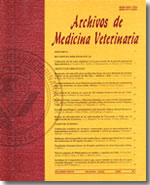Palatability and chemical composition of feeds ingested in captivity by Yucatan white-tailed deer (Odocoileus virginianus yucatanensis)
Main Article Content
Abstract
The study was conducted at the Regional University Center located in Temozon, north of Yucatan (Mexico). The dietary preferences of 10 white tailed deer (Odocoileus virginianus) subspecies yucatanensis were estimated in the selection of eleven plants growing in the state of Yucatan, using a cafeteria study type. The chemical composition and in vitro dry matter digestibility (IVDMD) of the diet and the different vegetal species were determined, as well as the nutritional balance of the deer (30.2 ± 2.65 kg of BW) fed with those species. The deer selected mainly the arboreal ones (76.52%), with a smaller proportion of forbs (19.37%), herbaceous (5.81%) and a minimum of graminae (0.29%). The legumes Leucaena leucocephala and Brosimum alicastrum constituted 51.20% of the ration. The diet had a composition of 56.97% dry matter, 17.64% crude protein, 42.53% cell walls with an IVDMD of 56.90%. The results of multiple linear regression analyses showed that the arboreal species have a significant impact (P < 0.0006) in the food consumption, whereas the crude protein tended (P < 0.096) to modify it. The analysis of variance showed that dry matter percentage influences the intake (P < 0.0085) in a quadratic form. Although the crude protein did not have an important effect in this analysis (P > 0.1), it presented a significant correlation (r = 0.23; P < 0.05), and none of the other nutrients or digestibility had a significant effect on feed intake. When the vegetal species were evaluated within the same analysis, the arboreal ones showed a significant positive linear effect (P < 0.0012) whereas the herbaceous tended (P < 0.11) to reduce the intake quadratically. It was estimated that the ration meets the maintenance requirements of nitrogen and energy in excess, allowing a maximum of 30% increase in energy for activity over the basal metabolism, a reason why the vegetation in Regional University Center can be considered nutritionally excellent due to its protein content and digestibility for the white tailed deer.

